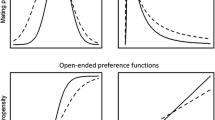Summary
Females of many species face a difficult sampling problem while searching for a mate. How do they find the best male possible when the constraints of time, memory, and mobility prevent them from visiting all the males in the population?
Five possible solutions are examined: random mating a fixed-threshold criterion, a fixed-threshold with last-chance option, an optimal one-step decision strategy, and the best-of-n-males strategy. Random mating is the worst strategy whenever the female gets more than one chance to mate. The two fixed-threshold strategies approach equal effectiveness as n increases but are always below the optimal one-step decision strategy. However, the best-of-n-males strategy always yields the highest expectation of fitness in a mate. The difference is especially great when n≳5.
Plotting the average fitness of males chosen vs n, the number of males examined, yields a negatively accelerating curve. Since the cost of searching will be an increasing function of n, the two curves can be combined to yield an optimum n: the point where the difference between the curves is greatest.
The one field study (Brown 1978) that addresses these problems in detail reveals that female mottled sculpins choose males on a relative, rather than absolute, basis, as theory suggests they should.
Similar content being viewed by others
References
Brown LP (1978) Polygamy, female choice, and the mottled sculpin, Cottus bairdi. Ph D dissertation, Ohio State University
Darwin C (1859) The origin of species by means of natural selection or the preservation of favoured races in the struggle for life, chap 4. Murray, London
Emlen ST, Oring LW (1977) Ecology, sexual selection, and the evolution of mating systems. Science 197:215–223
Hogg RV, Craig AT (1970) Introduction to mathematical statistics, 3rd edn. Macmillan, New York p 145
MacArthur RH (1972) Geographical ecology. Harper and Row, New York, pp 61–62
Mosteller F, Rourke REK (1973) Sturdy statistics: nonparametrics and order statistics. Addison-Wesley Reading MA, pp 248–263, 356–359
Orians GH (1969) On the evolution of mating systems in birds and mammals. Am Nat 103:589–603
Parker GA (1979) Sexual selection and sexual conflict. In: Blum MA, Blum NA (eds) Sexual selection and reproductive competition in the insects. Academic Press, New York, pp 123–166
Pleszczynska WK (1978) Microgeographic prediction of polygyny in the lark bunting. Science 201:935–937
Searcy WA (1979) Female choice of mates: a general model for birds and its application to redwinged blackbirds (Agelaius phoeniceus). Am Nat 114:77–100
Trivers RL (1972) Parental investment and sexual selection. In: Campbell B (ed) Sexual selection and the descent of man. Aldine, Chicago, pp 136–179
Author information
Authors and Affiliations
Rights and permissions
About this article
Cite this article
Janetos, A.C. Strategies of female mate choice: A theoretical analysis. Behav Ecol Sociobiol 7, 107–112 (1980). https://doi.org/10.1007/BF00299515
Received:
Accepted:
Issue Date:
DOI: https://doi.org/10.1007/BF00299515




